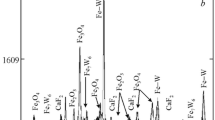Conditions for ensuring a high damping capacity in high-strength low-cost antifriction materials are determined depending on the content of manganese, methods of fabrication (traditional and powder metallurgy), and type of crystal lattice. The mechanisms of energy dissipation in cast and powder Fe – Mn alloys are studied and the special features of their structure responsible for the elevation of the damping capacity are determined. The possibility of replacement of classical high-damping alloys by Fe – Mn alloys with a hexagonal close-packed lattice is considered.
Similar content being viewed by others
References
Yu. K. Favstov, Yu. N. Shul’ga, and A. G. Rakhshtad, The Physical Metallurgy of High-Damping Alloys [in Russian], Metallurgiya, Moscow (1980).
T. F. Volynova, “A new class of high-strength damping alloys of the Fe – Mn system with structure of ε-martensite,” Perspekt. Mater., No. 2, 45 – 54 (1998).
M. A. Krishtal, Yu. Ya. Piguzov, and S. A. Golovin, Internal Friction in Metals and Alloys [in Russian], Metallurgiya, Moscow (1964).
T. F. Volynova, High-Manganese Steels and Alloys [in Russian], Metallurgiya, Moscow (1988).
L. I. Lysak and B. I. Nikolin, The Physical Fundamentals of Heat Treatment of Steel [in Russian], Tekhnika, Kiev (1975).
I. N. Bogachev and V. F. Egolaev, Structure and Properties of Iron-Manganese Alloys [in Russian], Metallurgiya, Moscow (1973).
G. G. Lukina and A. I. Mel’ker, “A study of relaxation phenomena in manganese ferrite,” in: Metal Science, Coll. Works [in Russian], Sudostroenie, Leningrad (1967), No. 11, pp. 75 – 81.
A. I. Mel’ker, “Astudy of phase transformations in iron-manganese alloys with the help of internal friction,” in: Coll. Works of Leningrad Polytechnic Institute [in Russian], Leningrad (1966), pp. 37 – 40.
Yu. N. Makagon and B. I. Nikolin, “Effect of multiple martensitic transformations on mechanical properties of steel G20 and steel 35G18,” Fiz. Met. Metalloved., 29, 32 – 36 (1970).
Yu. K. Favstov, “A device for determining internal friction in metals,” Zavod. Lab., No. 5, 606 – 608 (1959).
V. V. Matveev, G. Ya. Yaroslavtsev, B. S. Chaikovskii, and S. Yu. Kondrat’ev, Copper-Base High-Damping Alloys [in Russian], Naukova Dumka, Kiev (1986).
Author information
Authors and Affiliations
Corresponding author
Additional information
Translated from Metallovedenie i Termicheskaya Obrabotka Metallov, No. 12, pp. 23 – 27, December, 2009.
Rights and permissions
About this article
Cite this article
Volynova, T.F., Lushkin, M.A. & Buravlev, I.K. Damping properties of iron-manganese antifriction alloys with different types of crystal lattice. Met Sci Heat Treat 51, 589–593 (2009). https://doi.org/10.1007/s11041-010-9216-7
Published:
Issue Date:
DOI: https://doi.org/10.1007/s11041-010-9216-7




